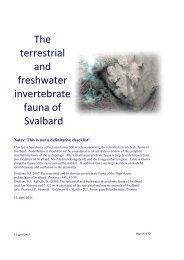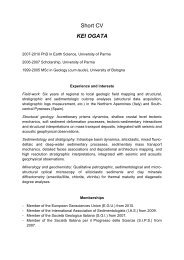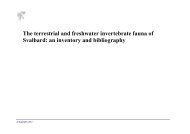Arctic plant ecology: From tundra to polar desert in Svalbard - Unis
Arctic plant ecology: From tundra to polar desert in Svalbard - Unis
Arctic plant ecology: From tundra to polar desert in Svalbard - Unis
Create successful ePaper yourself
Turn your PDF publications into a flip-book with our unique Google optimized e-Paper software.
It is expected that northward expansion of southern species dom<strong>in</strong>at<strong>in</strong>g <strong>in</strong> the Low<br />
<strong>Arctic</strong>, could cause problems <strong>to</strong> high arctic species with low competitive abilities.<br />
However, retreat<strong>in</strong>g glaciers may provide new habitats <strong>in</strong> which the high arctic<br />
species may colonise and persist dur<strong>in</strong>g periods of warmer climate . The ability <strong>to</strong><br />
colonise newly deglaciated terra<strong>in</strong> varies among species (Matthews 1992). In project<br />
3 we studied glacial succession patterns <strong>in</strong> the three bioclimatic zones <strong>to</strong> identify high<br />
arctic species that are not represented <strong>in</strong> up <strong>to</strong> 100 years old successional stages and<br />
therefore might be at risk of ext<strong>in</strong>ction <strong>in</strong> a warmer climate.<br />
Low temperatures dur<strong>in</strong>g a short grow<strong>in</strong>g season reduce soil nutrient availability.<br />
S<strong>in</strong>ce low temperature and low nutrient availability may <strong>in</strong>teract, it is difficult <strong>to</strong><br />
dist<strong>in</strong>guish the impact of each of these variables (Körner 2003). Counter<strong>in</strong>tuitively,<br />
leaves from <strong>plant</strong>s from extremely cold climates had been found <strong>to</strong> be richer <strong>in</strong><br />
macronutients (N, P) than <strong>plant</strong>s from warmer environments, which had been<br />
expla<strong>in</strong>ed as 'luxurious consumption' (Körner 1989). Locally, the <strong>in</strong>put of nutrient<br />
can be high <strong>in</strong> <strong>Svalbard</strong> due <strong>to</strong> birds or mammals. Especially high levels of nutrients<br />
are found under bird cliffs. The aim of study 4 was <strong>to</strong> test whether temperature per se<br />
controls <strong>plant</strong> growth or whether growth is constra<strong>in</strong>ed by temperature<strong>in</strong>duced<br />
nutrient shortage.<br />
In cold climates, <strong>plant</strong>s are generally smaller than <strong>in</strong> warm climates, and as life<br />
conditions become more adverse m<strong>in</strong>iaturization of <strong>plant</strong>s progresses. Are the<br />
vegetative and reproductive structures similarly affected (isometric allocation), or do<br />
<strong>plant</strong>s give priority <strong>to</strong> one of the two (asymmetric allocation), which would h<strong>in</strong>t at<br />
selective pressure (evolutionary adaptation)? In alp<strong>in</strong>e environments it has been found<br />
that the allocation of resources shifts <strong>to</strong>wards the reproductive structures as altitudes<br />
<strong>in</strong>creases (Fabbro & Körner 2003). In study 5, we explore this for the first time <strong>in</strong> the<br />
<strong>Arctic</strong>.<br />
Climate change is not only expected <strong>to</strong> result <strong>in</strong> warmer conditions <strong>in</strong> the arctic, but<br />
also more extreme weather. This may even <strong>in</strong>clude more frequent or more <strong>in</strong>tense<br />
freez<strong>in</strong>g events dur<strong>in</strong>g the grow<strong>in</strong>g period due <strong>to</strong> changed atmospheric circulation,<br />
despite overall (mean) warm<strong>in</strong>g. Freez<strong>in</strong>g resistance is the first and most fundamental<br />
environmental filter <strong>plant</strong> species have <strong>to</strong> pass <strong>to</strong> establish susta<strong>in</strong>able growth <strong>in</strong> the<br />
<strong>Arctic</strong>. However, even arctic <strong>plant</strong>s are susceptible <strong>to</strong> freez<strong>in</strong>g when they are active,<br />
i.e. dur<strong>in</strong>g the grow<strong>in</strong>g season. Tissues of arctic and alp<strong>in</strong>e <strong>plant</strong>s may <strong>to</strong>lerate almost<br />
any temperature (some even liquid nitrogen) when they are dormant, but might be<br />
killed by temperatures between 2 and 9 °C, when actively grow<strong>in</strong>g and flower<strong>in</strong>g.<br />
Hence, it is well established that extreme summer events are the critical issue <strong>to</strong> look<br />
at (for a review see Körner 2003). Dur<strong>in</strong>g the course, we tested the freez<strong>in</strong>g resistance<br />
of 12 species.<br />
Material and methods<br />
Thirteen students from Norway, Sweden and Germany, study<strong>in</strong>g at n<strong>in</strong>e different<br />
<strong>in</strong>stitutions, participated <strong>in</strong> the course. The students worked <strong>in</strong> groups of two or three.<br />
All students participated <strong>in</strong> data collection for all projects, whereas each group was<br />
responsible for study design, analys<strong>in</strong>g and writ<strong>in</strong>g about their study. Data were<br />
collected dur<strong>in</strong>g a seven days cruise with M/S S<strong>to</strong>ckholm. We visited 10 different<br />
4








